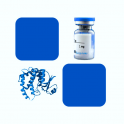
- Remove this product from my favorite's list.
- Add this product to my list of favorites.
Products
Newsletter
 |  |  |  |  |  |

Background
Nucleocapsid (N) protein is the most abundant protein found in coronavirus. CoV N protein is a highly immunogenic phosphoprotein important for viral genome replication and modulation of cell signaling pathways. It was first identified by a research team while they were screening for ADP-ribosylated proteins during coronavirus (CoV) infection (Grunewald M. E., et al. 2017, Virology; 517: 62-68). The array of diverse functional activities accommodated in N protein makes it more than a structural protein but also an interesting target in the development of antiviral therapeutics. Because of the conservation of N protein sequence and its strong immunogenicity, N protein of coronavirus is chosen as a diagnostic tool.
Source
Recombinant SARS Nucleocapsid protein, His Tag (NUN-S5229) is expressed from human 293 cells (HEK293). It contains AA Met 1 - Ala 422 (Accession # NP_828858.1).
Predicted N-terminus: Met 1
Molecular Characterization
This protein carries a polyhistidine tag at the C-terminus.
The protein has a calculated MW of 47.7 kDa. The protein migrates as 30-33 kDa and 55-60 kDa under reducing (R) condition (SDS-PAGE) due to Glycosylation.
Endotoxin
Less than 1.0 EU per μg by the LAL method.
Purity
>90% as determined by SDS-PAGE.
Formulation
Lyophilized from 0.22 μm filtered solution in PBS, Arginine, pH7.4, with trehalose as protectant.
Reconstitution
Please see Certificate of Analysis for specific instructions.
For best performance, we strongly recommend you to follow the reconstitution protocol provided in the CoA.
Bioactivity
Please refer to product data sheet.
Storage
For long term storage, the product should be stored at lyophilized state at -20°C or lower.
Please avoid repeated freeze-thaw cycles.
This product is stable after storage at:
-20°C to -70°C for 12 months in lyophilized state;
-70°C for 3 months under sterile conditions after reconstitution.
(1) "COVID-19 vaccine immunogenicity and safety surrounding fourth and subsequent vaccine doses in patients with hematologic malignancies"
Bhella, Wilkin, Hueniken et al
Vaccine (2024)
(2) "SARS-CoV-2 antigenemia and RNAemia in association with disease severity in patients with COVID-19"
Kim, Lawrence Panchali, Kim et al
Sci Rep (2024) 14 (1), 14926
(3) "Modulation of biophysical properties of nucleocapsid protein in the mutant spectrum of SARS-CoV-2"
Nguyen, Zhao, Myagmarsuren et al
Elife (2024) 13
Showing 1-3 of 55414 papers.
Recombinant SARS-CoV-2 (COVID-19) S1 protein, His Tag (MALS verified), 100µg - 507,00 €
Recombinant Biotinylated SARS-CoV-2 (COVID-19) S protein RBD, His,Avitag™ (MALS verified), 25µg - 507,00 €
Recombinant Biotinylated SARS-CoV-2 (COVID-19) S1 protein, His,Avitag™ (MALS verified), 25µg - 507,00 €
Recombinant SARS-CoV-2 (COVID-19) Nucleocapsid protein, His Tag, 100µg - 533,00 €
Recombinant SARS-CoV-2 (COVID-19) Nucleocapsid protein, His Tag, 100µg - 533,00 €
Follow us